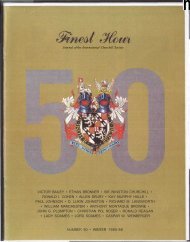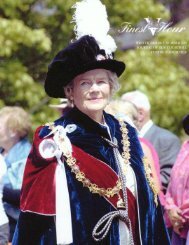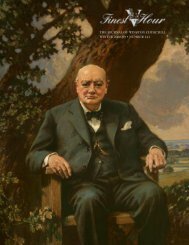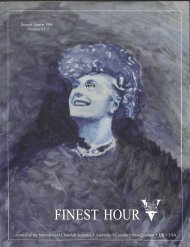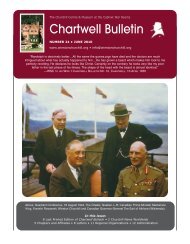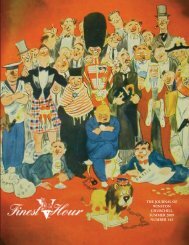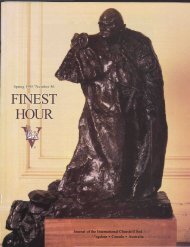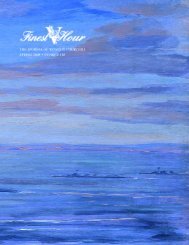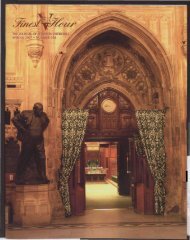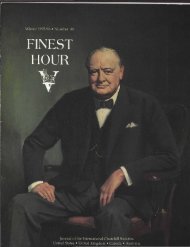You also want an ePaper? Increase the reach of your titles
YUMPU automatically turns print PDFs into web optimized ePapers that Google loves.
had proven that the North Atlantic could be flown even in<br />
winter. Beaverbrook was vindicated, the RAF had their<br />
bombers, and Ferry Command was born.<br />
Now the task was to find experienced, long-distance<br />
aircrews to continue this dangerous mission. The lure was<br />
the romance of flying, combined with the sense of patriotic<br />
duty. But in the neutral United States, all the recruiting was<br />
done in secret.<br />
Bennett and Beaverbrook enlisted the help of the<br />
Canadian Pacific Railroad to act as a cover and an organizational<br />
parent, which delivered the American-built planes to<br />
Montreal. From here they were flown to Gander, and then<br />
across the ocean. The transatlantic leg was done at night,<br />
since celestial navigation was the only method of holding a<br />
course. Naturally, if clouds covered the stars they would<br />
have to proceed by dead reckoning, for there were no radio<br />
beams and no radar.<br />
The planes had unpressurized cabins, no sound insulation,<br />
and no heat. Aircrews said that if it was 50 below<br />
outside, it was 50 below inside. Many men suffered from<br />
frostbite. When the planes were delivered, their chilled<br />
crews were sent back to Montreal by ship, a two-week trip<br />
that guaranteed seasickness and risked attack by U-boats.<br />
Later crews returned by air in the cold of converted bomb<br />
bays. Either way, it was not amusing work.<br />
Despite the challenges, Ferry Command delivered<br />
thousands of badly needed bombers on a regular basis:<br />
Lockheed Hudsons, B17 Flying Fortresses, B-24 Liberators,<br />
B-25 Mitchells and B-26 Marauders, as well as Canadianbuilt<br />
Lancasters and Mosquitoes. Then Ferry Command<br />
began to ferry VIPs on certain flights.<br />
“Some people take drugs,” <strong>Churchill</strong> said of his wartime<br />
Minister of Aircraft Production: “I take Max.” Facing page:<br />
Lord Beaverbrook, right, with his son, Group Captain Max<br />
Aitken, 1945 (photograph by Ian Smith). Below: Australian<br />
Donald Bennett, who formed the secret operation that<br />
became Ferry Command, and Air Chief Marshal Sir Charles<br />
Portal, Chief of Staff of the RAF, who in July 1942 told Bill<br />
Vanderkloot where he was going (Wikimedia Commons).<br />
Vanderkloot and <strong>Churchill</strong><br />
As one of the senior Ferry Command pilots at 24, my<br />
father began to fly VIP missions across the Atlantic to<br />
Britain and Africa. In less than two years at Ferry<br />
Command he accumulated over one million miles.<br />
In July 1942, having landed a new long-range Liberator<br />
in London with an important passenger, he was told to report<br />
to Air Chief Marshal Sir Charles Portal, head of the RAF.<br />
Portal asked the young captain a hypothetical question: If he<br />
were to fly to Cairo, what route would he take<br />
My father might have been surprised at the question.<br />
At the time, the Germans controlled North Africa and were<br />
advancing on Cairo itself. Nevertheless, he told Portal, “I’d<br />
take off just before dark, I’d go straight down the<br />
Mediterranean for a few minutes just to clear Tangiers, and<br />
I’d turn and go southeast, over the Atlas mountains; go<br />
south of the battle line, follow it straight through to the<br />
Nile River, turn north at the Nile and go into Cairo.”<br />
Portal told him: “Stay close to the phone.”<br />
The phone rang two days later at 8pm. Captain<br />
Vanderkloot was told that an RAF car would pick him up<br />
downstairs and to please come alone. Driving through the<br />
blacked out streets of London, they arrived at a dimly lit<br />
street. The driver told him to exit the car and walk to the<br />
middle of the block, where a light was shining over a<br />
doorway.<br />
He walked to the light. It was Downing Street. The<br />
door was numbered “10.” A butler opened the door and led<br />
him to the private office, where he was greeted by the<br />
British Prime Minister. Dressed in a bathrobe, <strong>Churchill</strong><br />
wasted no time on preliminaries: “Well, Captain<br />
Vanderkloot, I understand we’re going to Cairo.”<br />
Trying to take this all in, my father replied, “Yes sir, I<br />
suppose we are.”<br />
They would fly in a Liberator named Commando (see<br />
foregoing article by Chris Sterling)—an unarmed B-24<br />
painted flat black. It had few creature comforts and no passenger<br />
windows. A bed was constructed for the Prime<br />
Minister under the large fuel tanks near the wing. The rest<br />
of his party had to sit in seats in the converted bomb bay.<br />
My father was told that he could choose the night he<br />
wanted to leave, but was warned to tell no one. Portal said, “I<br />
am not to be told of the exact route of your flight, nor is<br />
anyone else. We know your departure points and your destinations.<br />
Details of anything that lies in between must remain<br />
secret, even to me. You are on your own. Good luck.”<br />
On a rainy night a few days later, a line of official cars<br />
arrived at RAF Lyneham. Waiting for their special passenger<br />
was a five-man crew, all Ferry Command veterans. Two<br />
were Americans: Captain Vanderkloot and co-pilot Jack<br />
Ruggles; three were Canadians: radio operator Russ<br />
Holmes, flight engineers Ron Williams and John Affleck.<br />
The oldest man among them was 26. >><br />
FINEST HOUR 148 / 21



